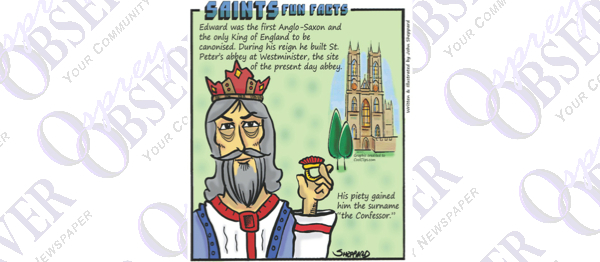By Kelly Wise Valdes
A canonized saint that is honored as a special protector is known as a patron saint. A patron saint may also be a benefactor of persons in a certain occupation or a guardian of those who bear the saint’s name. A patron saint may be invoked to intercede with God for help in a time of special need.
This month we are learning some interesting history about St. Edward the Confessor. St. Edward was born about 1003, the son of King Ethelred II the Unready and Emma, the daughter of Duke Richard I of Normandy. Edward lived in England until 1013 when the Vikings took the English throne. His family escaped to Normandy, but Edward returned to England in 1041 and was elected king.
King Edward made a vow of chastity and did not want to marry. But he was persuaded by his advisors to marry Edith, daughter of Earl Godwin of Wessex. She honored his vow of celibacy and they had no children.
King Edward was known for his religious faith and people believed that he could cure the sick by simply by touching them. This form of healing is called the king’s touch. King Edward’s reign was free from war and turmoil and he was often involved with religious matters, which also included building the great Benedictine Abbey, St. Peter’s at Westminster. The king’s life was drawing to a close just as the abbey at Westminster was almost completed.
King Edward reigned until his death in 1066 living a life renowned for generosity, piety and beneficent rule. He was buried in Westminster Abbey, which he had built. He was canonized in 1161. After his death, the Catholic Church made King Edward a saint. His body was translated into the Abbey within a special shrine behind the High Altar.
St. Edward’s unofficial title of peacemaker remained with him and he was declared the Patron Saint of England.
At the period of the Reformation, St. Edward’s shrine was violated, but it has since been restored and has become once again a place of pilgrimage.
Stay tuned next month while we explore the life of Our Lady of Lourdes.



